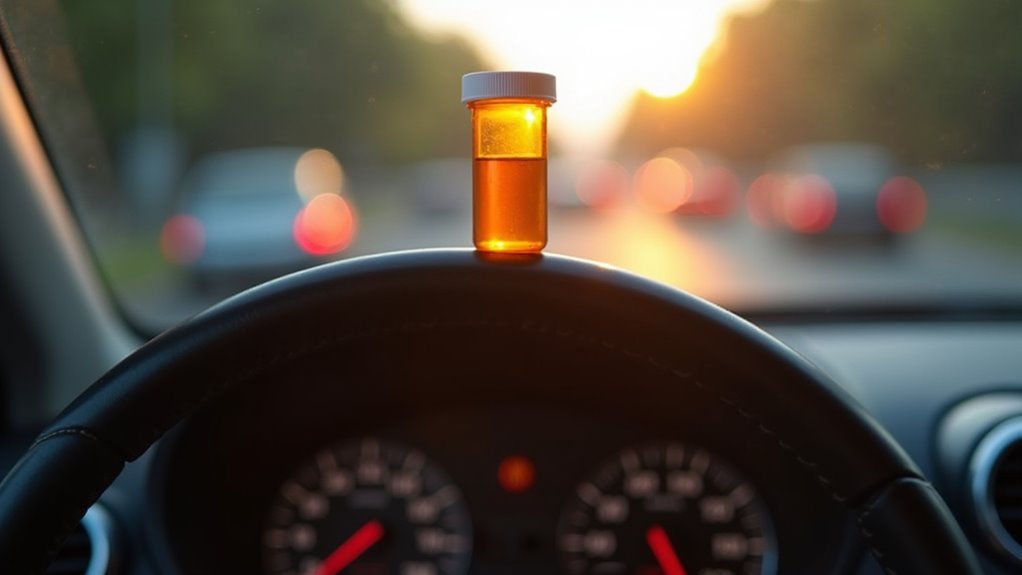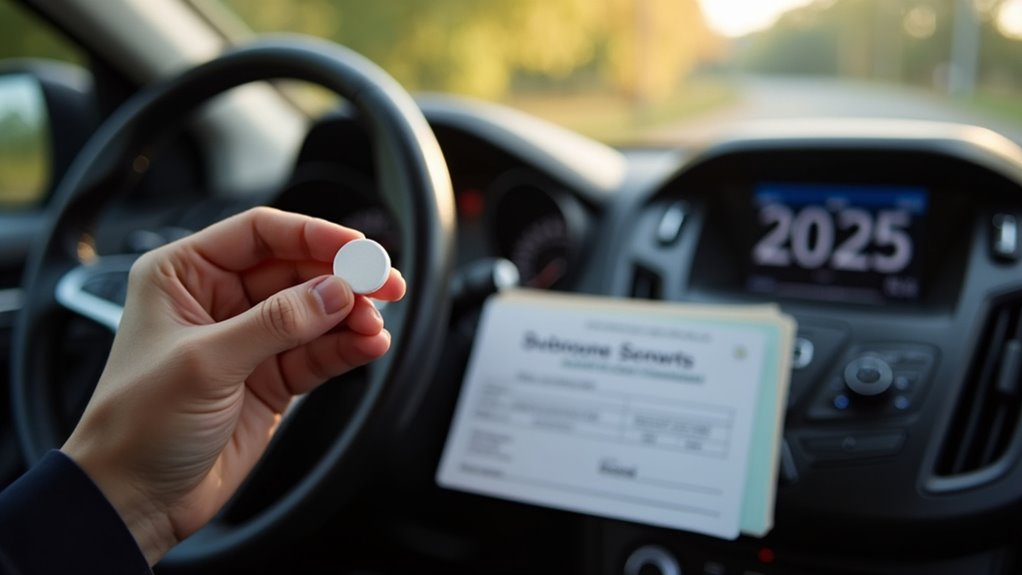You can legally drive while taking Suboxone in 2025 if you maintain a valid prescription and follow proper medical protocols. Federal law doesn’t explicitly prohibit Suboxone use while driving, but you’ll need documentation from your prescribing physician confirming your ability to operate a vehicle safely. Your medical examiner must evaluate your fitness to drive based on treatment stability, side effects, and dosing schedule. Understanding the specific requirements and safety considerations will guarantee your compliance with both federal and state regulations.
Legal Status of Driving on Suboxone Treatment

Driving while taking Suboxone involves a complex framework of federal and state regulations that continue evolving through 2025. You’ll need to understand that federal law doesn’t explicitly prohibit driving while using Suboxone as part of long-term opioid medication management. However, the DEA’s delayed implementation of new buprenorphine prescribing rules until December 31, 2025, maintains existing protocols for treatment oversight. Commercial drivers must obtain prescribing doctor approval to legally operate vehicles while on Suboxone treatment. Recent studies show that sublingual film users face increased risks of dental problems that could affect overall health and wellness during treatment.
Your ability to drive legally depends heavily on patient-provider communication and documented stability in your treatment program. State laws vary, but most focus on functional capacity rather than medication status alone. The TREATS Act aims to make telemedicine prescribing of buprenorphine permanent, which could affect how patients access treatment while maintaining their driving privileges. You’ll need proper documentation from your healthcare provider confirming that Suboxone doesn’t impair your driving ability. This typically requires ongoing assessment of your stability and adherence to prescribed treatment protocols.
DOT Requirements for Commercial Drivers

Three critical requirements shape commercial driving eligibility while using Suboxone under DOT regulations. Initial, you’ll need written clearance from your prescribing physician confirming your medication management doesn’t impair driving ability.
Second, you must undergo thorough medical evaluations, including consultation between the DOT examiner and your treating physician to verify treatment stability and safety. Since Suboxone is a Schedule III substance, medical examiners have discretion in making qualification determinations. The industry’s projected shortage of 175,000 drivers by 2026 has not changed these strict medical requirements.
Third, you’ll face ongoing compliance requirements, including periodic re-evaluations and monitoring for potential side effects. These standards apply regardless of employer accommodation policies, which may be more restrictive.
If you’re using Suboxone for maintenance while in remission from opioid use disorder, you’re more likely to qualify than those in active treatment. Remember, combined use with other medications like sedatives or opioids will trigger additional scrutiny and may result in disqualification. Drivers should expect up to 6 tests in their first year of employment as part of DOT’s random drug screening protocol.
Medical Documentation and Clearance Process

To obtain DOT medical clearance while taking Suboxone, you’ll need to submit a detailed documentation package that includes a clearance letter from your treatment provider, comprehensive treatment plan, and current lab results.
Your prescribing physician must provide written certification confirming your diagnosis, treatment effectiveness, and safety assessment for commercial driving. With the DEA’s revised rules, patients can now receive an initial six-month supply of buprenorphine through telemedicine consultations. The documentation must also demonstrate your stability in recovery through evidence of regular monitoring, consistent dosing, and absence of side effects that could impair driving ability.
Medical examiners will carefully evaluate your fitness to drive based on all submitted documentation. The documentation must also demonstrate your stability in recovery through evidence of regular monitoring, consistent dosing, and absence of side effects that could impair driving ability.
Required Medical Documentation Checklist
A detailed medical documentation checklist serves as the cornerstone for Suboxone patients seeking driving clearance in 2025. You’ll need extensive records demonstrating treatment duration factors exceeding 12 months and relapse risk indicators showing sustained stability.
Essential documentation requirements include:
- Treatment verification through counseling logs, negative drug screenings, and medication compliance records spanning at least one year
- Digital health records with secure timestamping, including prescriber consultations and side effect assessments
- Ongoing care evidence demonstrating active participation in support programs and regular monitoring of safety metrics
Providers must maintain complete telemedicine registration records in accordance with new DEA special registration requirements when prescribing Suboxone. Patients receiving treatment via telemedicine must have their parent or guardian present during prescription consultations if they are minors.
Your documentation must meet strict DEA guidelines while maintaining HIPAA compliance. Keep in mind that electronic records require verifiable authenticity and secure transmission protocols when sharing with medical examiners or FMCSA officials.
Physician Clearance Letter Requirements
Building upon your medical documentation portfolio, physician clearance letters represent a critical component for driving approval while using Suboxone in 2025. Your prescribing physician must explicitly address FMCSA compliance while maintaining patient confidentiality and medical records privacy standards.
Your clearance letter needs to include five mandatory elements: duration of treatment stability, side effect management assessment, relapse risk evaluation, exhaustive drug testing results, and prescriber contact information. Under the new regulations, prescribers must verify prescription data through state prescription drug monitoring programs before issuing clearance. Physicians must verify your identity and review PDMP data within seven days of telemedicine encounters. For remote consultations, documentation must align with new DEA guidelines permitting six-month audio-only prescriptions.
The letter should detail your counseling participation and confirm that you’re experiencing no driving-impairing side effects, supporting your ability to operate commercial vehicles safely.
Treatment Progress Records Protocol
Since maintaining thorough treatment records is essential for driving clearance, you’ll need to follow strict documentation protocols that align with 2025’s improved telehealth and PDMP requirements. Your treatment progress records must demonstrate consistent medication compliance and stability to support your driving privileges.
The final rule has eliminated special recordkeeping requirements for prescribers, streamlining the documentation process while maintaining essential safety standards.
Key documentation requirements include:
- Regular PDMP checks and verification timestamps from your healthcare provider to monitor prescription patterns and identify treatment discontinuation risk factors
- Detailed annual physical examination findings, including medication reviews and all-encompassing assessments that address patient access barriers
- Ongoing telehealth visit records showing stable treatment response, with mandatory change to video or in-person visits after six months
These records serve as vital evidence for physician clearance letters and help guarantee your continued ability to drive while on Suboxone therapy.
Safety Considerations and Risk Assessment
The safe operation of vehicles while taking Suboxone requires careful evaluation of multiple risk factors and safety considerations.
You’ll need to monitor pharmacokinetic factors and potential metabolic interactions that could affect your driving ability. Regular assessments of side effects like drowsiness or dizziness are imperative, as these symptoms can substantially impact your performance behind the wheel. Your medical examiner will evaluate your individual tolerance and response to treatment, considering both immediate and long-term safety implications. Licensed providers must approve your driving eligibility as part of your treatment plan.
Your stability in treatment plays a pivotal role in risk assessment. Maintaining vigilant oral health monitoring is crucial while taking sublingual strips to ensure no complications arise that could affect concentration. You must maintain consistent communication with your healthcare providers about any side effects and follow prescribed dosing schedules strictly. Documentation of negative drug screens and regular counseling attendance strengthens your safety profile. Remember, your medical certification may require ongoing monitoring to confirm continued safe driving capability.
State-Specific Laws and Regulations
Your state’s regulations for Suboxone use while driving can differ markedly from federal guidelines, with some jurisdictions imposing stricter monitoring requirements and testing protocols. You’ll need to verify your specific state’s laws regarding drug testing frequency, PDMP reporting requirements, and medical documentation standards for CDL holders using Suboxone.
While federal law provides the baseline framework, your state’s transportation authority may mandate supplementary compliance measures, such as random drug screening or more frequent medical evaluations.
State Laws Vary Widely
Legal regulations governing Suboxone use while driving differ greatly across state jurisdictions, creating a complex terrain for both medical providers and patients to navigate. State regulatory frameworks dictate varying requirements for prescription tracking databases and medical evaluations.
Your state may require immediate reporting to prescription monitoring programs and mandate regular checks before Suboxone prescriptions can be issued.
Medical documentation requirements differ markedly, with some states requiring detailed physician attestations about your ability to drive safely while on Suboxone.
Telemedicine regulations vary widely, with some states allowing remote prescriptions while others maintain strict in-person visit requirements.
You’ll need to understand your specific state’s laws regarding Suboxone use and driving, as requirements for medical certification, monitoring, and documentation can vary dramatically between jurisdictions.
Drug Testing Requirements Differ
Since drug testing procedures for Suboxone vary considerably across jurisdictions, you’ll need to understand both federal guidelines and state-specific requirements that govern medication monitoring. For example, Ohio mandates twice-per-quarter testing for MAT patients, while other states may have different state regulated screening requirements.
Standard workplace testing protocols don’t typically detect Suboxone unless specifically requested. Most pre-employment 5-panel and 10-panel tests won’t identify buprenorphine without special panels. To guarantee accurate workplace testing, employers must explicitly include buprenorphine screening in their drug panels. If you’re prescribed Suboxone legally, you may qualify for medical exceptions in workplace settings, but you’ll need to verify your state’s specific compliance measures and testing protocols to maintain treatment adherence. The medication combines buprenorphine and naloxone to help treat opioid addiction while preventing potential misuse.
Managing Side Effects While Driving
Managing side effects while driving on Suboxone requires a strategic approach to guarantee safety behind the wheel. During your routine medical exams, discuss any medication interactions that could amplify drowsiness or impair coordination. Your physician can help optimize your dosing schedule to minimize side effects during driving hours.
To effectively manage side effects while driving, follow these essential practices:
- Allow 4-6 hours after taking Suboxone before operating a vehicle to assess your tolerance and reaction time
- Stay hydrated and maintain proper nutrition to reduce nausea and dizziness
- Take scheduled rest breaks during long trips to combat potential fatigue
If you experience severe side effects, contact your healthcare provider immediately to adjust your treatment plan. Remember to carry proper documentation of your prescription in case of traffic stops.
Required Testing and Monitoring Protocols
Thorough testing and monitoring protocols safeguard both drivers and the public when operating vehicles while on Suboxone. You’ll need to maintain detailed documentation of your prescription adherence monitoring, including regular assessments from your prescribing physician and Medical Examiner.
Independent health assessments are imperative, focusing on your physical and cognitive fitness for commercial driving. You must provide proof of stable treatment status and undergo periodic evaluations to guarantee Suboxone isn’t affecting your ability to operate a vehicle safely. While federal guidelines don’t require specific Suboxone testing, you’ll need to comply with FMCSA regulations regarding controlled substances.
Your Medical Examiner will review your treatment documentation, side effect monitoring, and health status updates to preserve your certification. Stay prepared for sobriety assessments during traffic stops if impairment is suspected.
Treatment Compliance and Recovery Progress
You’ll need to demonstrate consistent treatment compliance through documented milestones in your Suboxone program, including regular drug screenings and attendance records.
Your healthcare provider will track your recovery progress through standardized assessments, measuring factors like sustained abstinence, medication adherence, and cognitive functioning.
Active participation in counseling programs provides supplementary evidence of your commitment to recovery and readiness to maintain driving privileges.
Monitoring Treatment Milestones
Successful Suboxone treatment requires consistent monitoring of specific milestones to verify safe driving capabilities. Through telehealth integration, your healthcare providers can track treatment adherence measures and evaluate your progress in real-time.
Your treatment milestones will be monitored through:
- Regular sobriety assessments via blood tests and behavioral evaluations to confirm you’re maintaining recovery without impairment
- Documentation of consistent attendance at counseling sessions and support group meetings, demonstrating your commitment to treatment
- Ongoing telehealth reassessments that enable quick adjustments to your treatment plan and dosage modifications when needed
Your medical examiner will review these milestones during DOT physicals to ascertain you’re meeting safety requirements for commercial driving. Treatment stability and consistent progress greatly impact your certification eligibility.
Recovery Documentation Requirements
Maintaining proper documentation of your Suboxone treatment has become more streamlined through telemedicine integration in 2025. You’ll need to follow a thorough medical examination schedule that includes initial evaluations and annual reviews of your progress. Within 14 days of starting treatment, you must complete an in-person physical exam, with subsequent yearly assessments to evaluate medication effectiveness and recovery goals.
Your provider will document all telemedicine visits, including substance use screenings and treatment milestones. Patient confidentiality protection remains paramount – all records, whether from remote or in-person visits, are secured under HIPAA regulations. You’ll need to provide consent for data sharing between healthcare providers, and your treatment facility must maintain organized documentation of both virtual and physical encounters for regulatory compliance.
Counseling Program Participation
Participating in counseling programs remains a cornerstone requirement for Suboxone treatment compliance in 2025. Treatment adherence standards mandate regular engagement with licensed professionals who meet strict staffing competency requirements.
Your treatment plan will incorporate both medication management and psychosocial support services to optimize your recovery outcomes.
Key aspects of your required counseling participation include:
- Attending scheduled sessions with credentialed addiction specialists within 14 days of starting treatment
- Engaging in periodic behavioral health assessments to track your progress and adjust treatment approaches
- Participating in both individual and group counseling sessions, available through in-person or telehealth options
Your active participation in counseling helps guarantee thorough care while supporting your ability to safely maintain daily activities, including driving, when properly stabilized on Suboxone.
DUI Implications and Legal Protections
The legal implications of driving while using Suboxone center on DUI enforcement and patient protections. While you’re shielded from employment discrimination based solely on Suboxone use, you must still demonstrate that your treatment doesn’t hamper your driving ability. Patient privacy considerations under HIPAA safeguard your treatment details, though you’re required to disclose this information during medical evaluations.
You could face DUI charges if you show signs of impairment, but mere Suboxone use isn’t automatically incriminating. Since it’s a Schedule III medication with lower abuse potential, prosecution typically requires proof of actual impairment. Your medical documentation of controlled use and compliance with prescribed treatment can serve as a strong defense. Bear in mind that while federal law doesn’t prohibit driving on Suboxone, state regulations may vary.
Best Practices for Safe Driving on Suboxone
Safe operation of a vehicle while undergoing Suboxone treatment requires strict adherence to established medical protocols and safety guidelines. Implementing medication optimization strategies guarantees you’re maintaining proper dosage levels while minimizing potential side effects that could impact your driving ability.
As part of your long-term relapse prevention plan, you’ll need to consistently monitor and report any changes in how the medication affects you.
- Coordinate with your healthcare provider to schedule dosing times that don’t interfere with your peak driving hours
- Document any side effects in a daily log, particularly those affecting alertness or reaction time
- Maintain regular communication with your treatment team to adjust medication levels if needed
Following these practices helps establish a documented pattern of responsible medication management and safe driving behavior.
Frequently Asked Questions
How Long After Taking Suboxone Should I Wait Before Driving?
You should wait 3-5 hours after taking Suboxone before driving, as this is when peak concentration typically occurs. Monitor yourself during this window and remain alert for medication effects like drowsiness or dizziness.
If you’re new to treatment, extend your waiting period to guarantee stability. Always avoid driving if impaired, regardless of timing. Consult your healthcare provider for personalized guidance based on your dosage and individual response.
Can I Take Suboxone While Driving if I Feel Withdrawal Symptoms?
You should never take Suboxone while driving, even if experiencing withdrawal symptoms. Pull over to a safe location initially. Taking medication while operating a vehicle risks unsafe administration and unpredictable medication interactions.
Instead, work with your healthcare provider to establish appropriate dosage levels and timing that prevent withdrawal during driving hours. If you’re experiencing breakthrough symptoms, adjust your dosing schedule with medical supervision to maintain stable treatment coverage.
Will My Car Insurance Rates Increase if I’m Prescribed Suboxone?
Your insurance rates won’t automatically increase just because you’re prescribed Suboxone. However, you should notify your insurance provider about your medication status to guarantee proper coverage. Focus on demonstrating responsible drug interaction monitoring through regular doctor visits and documented stable treatment.
If you’re concerned about side effects, consider having transportation alternatives available. Keep detailed medical records showing treatment compliance, as this can help maintain standard insurance rates.
Should I Carry My Suboxone Prescription While Driving Across State Lines?
Yes, you should always carry your original Suboxone prescription and prescribing physician’s letter when crossing state lines. You’ll avoid potential difficulties obtaining prescriptions in unfamiliar locations and protect yourself during law enforcement interactions.
Proper storage of documentation in a secure, waterproof container is essential to maintain legibility. Keep these documents with your driver’s license and vehicle registration to guarantee quick access when needed.
Can Employers Request Random Drug Tests Specifically for Suboxone Use?
Employers can’t legally request drug tests specifically targeting Suboxone use without justifiable cause. Employee policies must be non-discriminatory and apply consistently across all prescribed medications.
Your medical privacy concerns are protected under ADA regulations when you’re using Suboxone as prescribed. However, if your job involves safety-sensitive duties, your employer may require medical documentation confirming your fitness for work, but this must follow established testing protocols for all employees.







